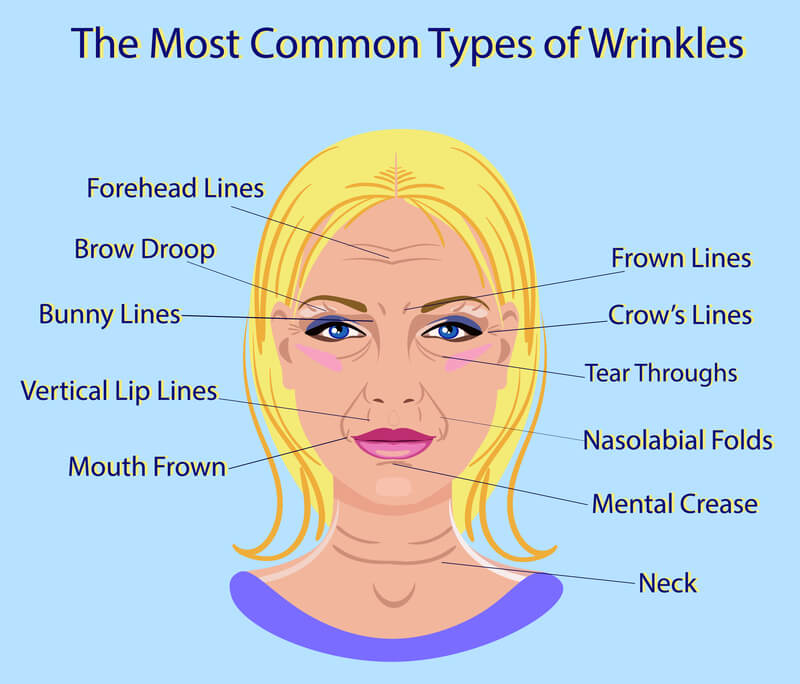Common Types of Facial Wrinkles (Rhytides)

Facial wrinkles (or Rhytides as we call them in the medical community) are a natural part of growing older. As you age, the levels of skin firming proteins like collagen and elastin decline and natural oils in the skin subside. Additionally, cumulative damage from years of UV and free radical exposure take their toll. These variables contribute to the appearance of wrinkles. Since skin on the face and neck are thinner, they are often some of the first areas of the body to show signs of aging. The formation of wrinkles may be hastened by genetics, exposure to the sun, smoking, air pollutants, nutritional deficiencies or lack of hydration.
Facial wrinkles appear most dramatically in areas frequently creased by repeated facial expressions. There are different types of wrinkles. Wrinkles may be dynamic, meaning they only appear when performing certain facial movements, or static, meaning they are visible all the time, even at rest.
While fully preventing wrinkles is not possible, one can minimize the visual effects of skin aging. This includes practicing daily sun safety (such as wearing an SPF of 30+ and sun protective hats and clothing), eating a healthy nutrient dense diet, exercising regularly and maintaining a physical grade skin care regimen that includes peptides, hyaluronic acid, and stem cells that promote skin hydration and stimulate collagen synthesis.
Along with sun avoidance and a healthy lifestyle, in office procedures such as injectables like neuromodulators (Botox, Dysport, Xeomin) or dermal filler (Juvederm, Restylane), chemical peels, laser treatments and energy devices can further aid in the reduction of static and dynamic wrinkles.
While wrinkles are an inevitable part of the aging process, many people find them to be cosmetically displeasing. If you’re wondering about options for treating your wrinkles, identifying which types of wrinkles you have is a good place to start.
Marionette Lines
What are They?
Marionette lines are c-shaped and vertical lines that frame the chin, similar to the visible lines on a ventriloquist’s puppet. These lines run from the corners of the mouth to the jawline.
What Causes Them?
Marionette lines are caused by a combination of decrease in volume in the midface and overactivity in the muscles associated with frowning. These muscles pull down on the corners of the mouth and a decrease in collagen and elastin in the midface and cheeks cause sagging that create static wrinkles.
Forehead Lines
What are They?
Forehead lines are horizontal wrinkles which run across your forehead caused by your fontalis muscle. They tend to me more pronounced when you raise your eyebrows and there are likely several of them in parallel above the eyebrows. Forehead lines can be dynamic or static.
What Causes Them?
These wrinkles are caused by the repetitive action of raising the eyebrows, which activates the frontalis muscle to pull the skin of the forehead and brow upwards. Forehead wrinkles may appear worse if the skin is dehydrated.
Frown Lines
What are They?
Frown lines are the vertical lines between the eyebrows. They are sometimes referred to as eleven lines or worry lines. Although they are called frown lines, these lines can appear even when smiling.
What Causes Them?
These wrinkles are caused by repetitively furrowing, frowning or even squinting of the brows and eyes. The area is referred to as the glabella, which is composed of five different muscles and their purpose is to allow for depression of the brows.
Nasolabial Folds (Laugh Lines)
What are They?
Nasolabial folds are frequently referred to as smile lines or laugh lines because they are most apparent when we are smiling. These are the lines that run from the lower outside corners of your nose to the corners of your mouth.
What Causes Them?
Nasolabial folds are caused by repetitive smiling, but are also emphasized by a loss of structure in the cheeks. The nasolabial crease deepens as we age due to a breakdown of collagen and elastin.
Bunny Lines
What are They?
Bunny lines are vertical or slightly diagonal wrinkles on either side of the nose, similar to lines that would appear as a bunny scrunches its snout. These fine diagonal nose wrinkles become more visible when smiling or laughing.
What Causes Them?
Bunny lines are formed when you flex the upper nasalis muscle on the sides of your nose and contraction of the levator labii superioris alaque nasi muscles that run alongside the nose.
Crow’s Feet
What are They?
Crow’s feet, or peri-orbital wrinkles, are the horizonal and diagonal lines that surround the eyes. They are often more prominent when we laugh or smile.
What Causes Them?
Crow’s feet are caused by contraction of our orbicularis oculi muscle that surrounds our eye. These wrinkles deepen after a lifetime of laughing, smiling and squinting. Because the skin around the eyes is so delicate, they are often the first wrinkles many people notice.
Lip Lines
What are They?
Lip lines are also called lipstick lines, smoker’s lines or hatch lines. These are the tiny vertical lines that appear along the upper edge of the lips, and even on the lips themselves.
What Causes Them?
They are caused by a combination of contraction of our orbicularis oris (the circular muscle surrounding the mouth), dehydration and aging. Because the lips are prone to dryness, this area is among the first to show signs of dehydration. Smoking and pursing of the lips such as frequent drinking from straws will also contribute to these lines.
Mental Crease
What is This?
The mental crease is a horizontal downward curving wrinkle between the lower lip and chin. This wrinkle is named for the crease that forms above the chins mentalis muscle.
What Causes It?
The mental crease is caused by pouting and contraction of the mentalis muscle over the course of your life. This crease becomes more apparent with age.
Neck Lines
What are They?
Neck lines, also referred to as neck bands or necklace lines, are horizontal lines that span across the neck. There are typically multiple neck line wrinkles, and some can even be vertical.
What Causes Them?
Repetitively looking down can cause neck lines. The relatively new habit of looking down at cell phones has caused an increase in neck lines, also referred to as tech neck. This area is also frequently exposed to the sun, and many people forget to put sunscreen on their neck – which contributes to the formation of these wrinkles.
Disclaimer: The contents of the Westlake Dermatology website, including text, graphics, and images, are for informational purposes only and are not intended to substitute for direct medical advice from your physician or other qualified professional.

I have bookmarked your page that is explain very well. We will be sure to show this to our patients. Great detailing of different facial wrinkles. You should do dedicated blog posts on each wrinkle, I would like to understand treatment options.
Will do Michelle 🙂
We’re in the process of expanding this content on our blog and will link to the new posts as we create them. Please be sure to check back on this post often. Or we can send you an email with the links once finished if you like!